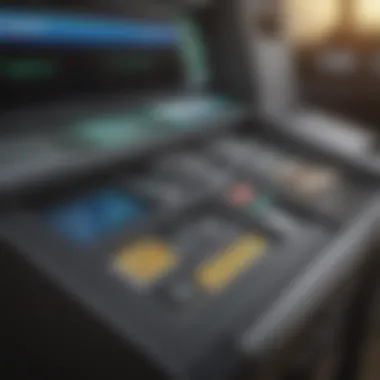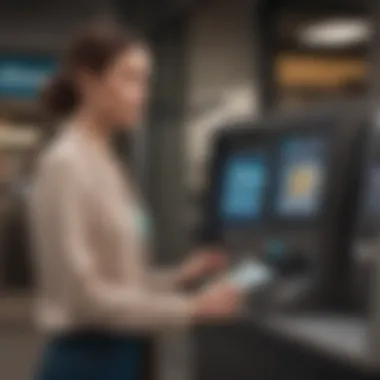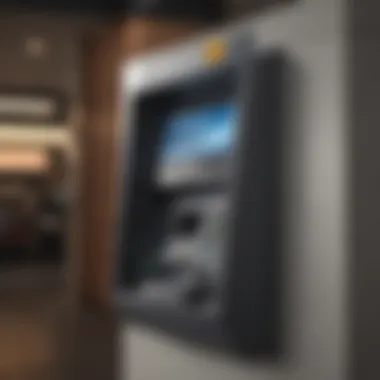Cashing a Check at ATM: A Complete Guide


Intro
In today's fast-paced world, managing finances efficiently is crucial. One of the common tasks that individuals face is cashing checks. Traditional methods like visiting a bank or check-cashing stores can be time-consuming. However, ATMs offer a modern, convenient alternative for cashing checks. This guide aims to provide a comprehensive exploration of the process, ensuring you have all the information you need to navigate this banking feature.
Understanding Cashing a Check Through ATM
Cashing a check via an ATM is different than traditional methods. Understanding this process involves knowing the requirements, procedures, and any potential issues you may encounter. Additionally, comparing ATM cashing with conventional methods highlights the advantages and disadvantages of each approach. Security and fees are also essential aspects that need consideration for anyone looking to optimize their banking experience.
Necessary Requirements
Before using an ATM to cash a check, ensure you have completed the following:
- A valid check made out to you.
- Your ATM/debit card associated with the bank account.
- A government-issued photo ID may be required by some institutions.
Step-by-Step Procedure
Cashing a check at an ATM typically follows these steps:
- Insert your card into the ATM.
- Enter your PIN.
- Select the option for cashing a check (this may vary based on the bank's interface).
- Follow prompts to scan or enter your check details.
- Choose how much cash to withdraw from the check amount.
- Collect your cash and receipt.
Potential Pitfalls
Despite the convenience, there are challenges to be aware of:
- Deposit Hold: Checks might not be available for immediate cashing if the amount is significant or if the issuing bank is different.
- ATM Limits: There could be withdrawal limits that restrict how much cash you can access.
- Technical Issues: Sometimes, ATMs might experience glitches that could cause frustration.
Comparing Traditional Methods with ATM Cashing
Cashing checks at the bank involves a face-to-face interaction that can be beneficial for some individuals but requires more time. In contrast, ATMs provide immediate access without lines or waiting for a teller.
Security Considerations
When cashing checks via ATM, security is essential. Always use ATMs in well-lit, familiar areas and be cautious of your surroundings while conducting transactions. Use your card and PIN securely to avoid unauthorized access to your account.
Fees to Consider
While many banks allow you to cash checks through their ATMs for free, some institutions may charge fees, particularly at non-affiliated ATMs. Be sure to check with your bank for potential charges.
Understanding ATMs
Understanding ATMs is crucial for anyone looking to manage their banking needs more efficiently. Automated Teller Machines (ATMs) have drastically transformed how individuals access their funds. They offer convenience and flexibility, allowing users to perform various transactions without visiting a bank branch. With a clear comprehension of ATMs, users can unlock the full potentials of these machines, from cash withdrawals to check depositing and cashing.
What Are ATMs?
Automated Teller Machines are electronic devices that provide customers with access to their bank accounts. Customers can use ATMs to withdraw cash, check account balances, deposit checks, and more. They serve as a bridge between the consumer and the bank, offering a self-service banking option around the clock. ATMs provide services that streamline banking transactions, thereby enhancing customer satisfaction.
Types of ATMs
ATMs come in various types to serve different user needs and preferences.
- Bank ATMs: These machines belong to a specific bank and offer services to its customers. They typically provide full banking capabilities, including cash withdrawals, deposits, and balance inquiries.
- Retail ATMs: Found in places like supermarkets or convenience stores, these ATMs may charge additional fees for transactions, especially if they do not belong to the user’s bank.
- Offshore ATMs: Used primarily in foreign countries, these ATMs are handy for travelers needing cash in local currency. Fees may apply, and exchange rates can vary.
- Mobile ATMs: These are temporary machines set up for events such as festivals or concerts, usually to serve a large number of attendees.
Understanding the type of ATM is important, as it influences fees, functionality, and accessibility.
Capabilities of Modern ATMs
Modern ATMs have evolved beyond simple cash dispensers. Many offer a range of advanced features that make banking more convenient.


- Check Cashing: Some ATMs allow users to cash checks directly, eliminating the need for a bank teller.
- Cardless Withdrawals: Users can often withdraw cash using their mobile devices instead of a physical bank card, enhancing security.
- Multilingual Support: Many ATMs now offer interfaces in multiple languages, catering to diverse populations.
- Deposit Functionality: Users can deposit cash or checks through ATMs, making them more versatile.
- Account Transfers: Some ATMs allow users to transfer funds between their accounts.
Overall, understanding the capabilities of modern ATMs enhances user experience and promotes better financial management.
Cashing a Check via ATM
Cashing a check through an ATM is an important topic for many individuals who prefer handling their financial matters independently. It offers a seamless way to access funds without needing to visit a bank branch. This convenience can save time and effort, especially for those managing busy schedules. The use of ATMs for cashing checks is becoming increasingly prevalent due to advances in technology and banking services.
Initial Requirements
Banking Relationship
A strong banking relationship is essential when cashing a check via ATM. Many banks require customers to have an account with them. This affiliation provides easier access to services like check cashing. The crucial aspect of this relationship is trust. Banks trust their customers, and customers trust banks to handle their finances securely.
Having an account can be a beneficial choice since it often allows higher transaction limits. For instance, a user may be limited in the amount they can cash at an ATM without an account. However, dependence on the banking relationship can be a disadvantage if one does not have an account and needs cash urgently.
Identification Documents
Identification documents are vital for cashing a check at an ATM. You typically need to present a valid ID, such as a driver’s license or a passport. The primary purpose of these documents is to verify your identity. This verification is crucial to prevent fraud and ensure that the check is being cashed by the rightful owner.
A significant advantage of providing identification is that it adds a layer of security to the transaction. For those without proper identification, this can be a setback, as cashing a check becomes impossible without verification. In summary, without the right identification documents, the process can be significantly delayed or even blocked entirely.
Step-by-Step Process
Locating the ATM
The first step is locating the appropriate ATM for check cashing. Not all ATMs have this capability. Typically, banks will have ATMs clearly marked for cashing checks. This step is significant because using the correct ATM streamlines the entire process.
Many banks provide a locator tool on their websites or mobile apps. This feature is beneficial as it saves time searching for an ATM. The disadvantage can be when one is in an unfamiliar area, making the search more challenging.
Inserting Your Card
Once you have found the right ATM, inserting your card comes next. This step is straightforward but critical, as it begins the transaction process. Proper insertion ensures the ATM recognizes your card. If there are issues, it may cause frustration and delays.
Being part of your bank’s network can be advantageous, as it may allow you to avoid fees. However, using an out-of-network ATM could lead to additional charges.
Selecting the Check-Cashing Option
After inserting your card, you will select the check-cashing option. This functionality is essential because it differentiates cashing checks from regular withdrawals. The option should be readily visible on the ATM screen.
This selection is a significant point in the process, as not choosing the correct option can lead to errors. Some ATMs may limit the types of checks that can be cashed, which is an important consideration for users.
Endorsing the Check
Endorsing the check is another critical step in this process. Users often must sign the back of the check in designated areas. This endorsement validates the check for cashing. Without this signature, the transaction cannot proceed.
An essential aspect of endorsing is ensuring that your signature matches what is on record with your bank. Failing to do so can cause the check to be rejected. Users should pay close attention to this aspect to avoid unnecessary complications.
Finalizing the Transaction
Finally, finalizing the transaction is the last step. Once the check is cashed, it is important to follow the prompts on the ATM screen. Ensure that you receive your cash or receipt correctly before leaving the ATM.
This step is crucial as it concludes the entire process. A common issue could arise if someone forgets or fails to take their card or cash output. Such incidents can lead to security risks and potential losses.
It is critical to understand that while cashing a check via ATM is convenient, careful attention to each step is necessary to ensure success.
Advantages of Using ATMs for Check Cashing
Cashing a check through an ATM has become an increasingly popular method in recent years. This section delves into the specific advantages of using ATMs for this purpose. Understanding these benefits is crucial for modern banking users looking to maximize convenience and efficiency.


Convenience
The convenience provided by ATMs cannot be overstated. Users can access their funds anytime and anywhere, eliminating the need to visit a traditional bank branch during business hours. This flexibility allows individuals with busy schedules to manage their finances without having to adjust their daily routines. It is also especially beneficial for those who live in remote areas where banking facilities may be limited.
In addition to the accessibility, ATMs often provide a simple and straightforward interface for processing check cashing. Users can complete transactions quickly, which is ideal for those who might be unfamiliar with banking operations or are limited by time constraints. Overall, the convenience of ATMs enhances the banking experience significantly.
Extended Hours of Operation
Most ATMs offer extended hours of operation compared to traditional banks. This means that cashing a check is not restricted to regular banking hours. Users have the ability to perform transactions late at night or even on weekends, making it easier for those who work conventional day jobs to manage their funds. This extended availability is also advantageous for spontaneous transactions, as users can cash checks at their own convenience.
Moreover, some banks have ATMs that are operational 24 hours a day, which adds a layer of accessibility that can be crucial for people who need immediate access to cash. This ability to use ATMs outside of regular banking hours eliminates the frustration of long queues experienced at physical bank locations.
Reduced Waiting Times
Cashing a check at an ATM typically results in reduced waiting times when compared to visiting a bank teller. When using a traditional bank, customers often face long lines and extended wait periods. This can be particularly cumbersome when the bank is busy, and time is of the essence.
In contrast, ATMs allow users to process their transactions independently. Most ATMs are designed to handle multiple users efficiently, leading to shorter wait times overall. Furthermore, many modern ATMs can accept checks quickly and will provide immediate feedback on whether the transaction is successful or not. This instant confirmation enhances the user's experience by reducing uncertainty and allowing for better financial planning.
The shift to using ATMs for check cashing represents a significant evolution in the way individuals manage their banking needs.
In summary, the advantages of using ATMs for cashing checks include unparalleled convenience, extended hours of operation, and significantly reduced waiting times. These elements combine to create a more efficient banking experience, particularly appealing to credit score improvers, first-time borrowers, and financial novices looking for effective financial management.
Potential Drawbacks
Cashing a check through an ATM might seem convenient, but it is essential to be aware of certain potential drawbacks. Understanding these limitations can help you make informed decisions about your banking options and avoid unnecessary frustrations. While ATMs offer many advantages, they also come with specific considerations that can impact your experience.
Transaction Limits
One key drawback is the transaction limits typically set by banks. Each ATM may impose a maximum amount you can withdraw or cash in a single transaction. These limits can vary depending on the bank, the type of account you hold, and even the ATM’s own settings.
For instance, your bank may allow you to cash a check but limit it to $500 per transaction. If you have a larger check to cash, you may need to repeat the process multiple times, which can be inconvenient and time-consuming. Some banks provide clear information on their websites about these limits, but it is beneficial to check with your bank directly for the most accurate details.
Fees and Charges
Another important consideration involves the fees and charges associated with using ATMs for check cashing. Although many banks own the ATMs on their premises, usage fees may still apply, especially if you are using an ATM that is not affiliated with your bank. These fees can range from a few dollars to significantly higher amounts depending on your transaction and your bank’s policies.
Tip: Always verify the fee structure of your bank to avoid surprise charges when cashing a check at an ATM.
Additionally, check-cashing services at standalone ATMs might charge higher rates. Understanding these costs will help you evaluate whether using the ATM is the best financial choice for your situation.
Check Clearance Times
Check clearance time is another potential downside. When cashing a check through an ATM, the funds may not be immediately available for withdrawal. Banks often place holds on checks to prevent fraud and ensure that the check is valid. Depending on your bank’s policies, the hold period can range from a day to several days before the funds are accessible.
This delayed availability can create challenges, particularly if you need immediate access to funds. If you rely heavily on quick transactions, understanding your bank's check clearance timelines becomes crucial. Be sure to inquire about how long you might wait after an ATM transaction before the money is available for use.
Security Considerations
When it comes to cashing a check through an ATM, security holds paramount importance. It is essential to safeguard personal information and financial assets during these transactions. The convenience of using ATMs should not overshadow the potential security risks involved. Understanding and addressing these risks allows users to protect themselves effectively while making use of modern banking technology.
Protecting Your Information
To ensure your personal data remains secure while cashing a check via ATM, you should adopt several protective measures. Begin by always using ATMs located in well-lit and populated areas. This minimizes the chances of falling victim to any illicit activities. At the same time, be sure to keep your banking information private. Avoid sharing your PIN or account details with anyone, even with trusted friends or family.
Regularly monitoring your bank statements for unusual activities is critical. This can help you identify unauthorized transactions promptly. In addition, enabling any available alerts on your bank account can notify you of significant account changes, further increasing your awareness. Finally, utilize strong and unique passwords for your online banking account. This will help prevent unauthorized access to your account and maintain your financial security.
Identifying Unsafe ATMs
Being able to recognize an unsafe ATM is vital for preventing criminal activities. Here are some signs to look for when assessing the safety of an ATM:


- Unusual Appearance: An ATM that looks damaged or modified might be tampered with.
- Skimming Devices: Watch for any suspicious attachments on the card reader. These devices can log your card information without your knowledge.
- Poor Location: ATMs located in isolated or poorly illuminated areas can present higher risks.
- Unrequested Transactions: If an ATM behaves erratically – such as ejecting cards or asking for multiple entries of your PIN – it could be compromised.
If you feel uncertain about an ATM's safety, it is prudent to relocate to another machine. Trust your instincts. Ensuring your personal safety while cashing checks is crucial. Always prioritize security over convenience when dealing with financial transactions.
Comparison with Traditional Check Cashing
Understanding the differences between ATM check cashing and traditional methods is essential for anyone looking to manage their finances effectively. This comparison provides insight into the convenience, speed, and access of each method. By exploring their benefits and considerations, individuals can determine which option best suits their needs.
Bank Teller Services
Using a bank teller for cashing a check offers a personalized approach. Bank tellers can provide guidance and help with any questions about the check's validity or banking procedures. This method often includes additional services like cash deposits or transfers, which an ATM does not offer. However, there are certain limitations.
- Limited Hours: Bank tellers typically operate during standard business hours, which can be inconvenient for those with hectic schedules.
- Increased Waiting Time: There might be a queue, especially during peak hours, causing delays for the customer.
- Higher Transaction Limits: Some banks may offer higher cash limits compared to ATMs, which makes it more feasible for larger checks.
Bank teller services present a traditional banking relationship, providing a level of assurance about the transaction that is less definitive with electronic methods.
Check-Cashing Outlets
Check-cashing outlets (CCOs) provide another avenue for individuals needing quick access to cash. These facilities operate independently of traditional banks and usually have more flexible hours.
- Accessibility: Many CCOs are open longer than banks, and some even operate 24/7, catering to a broad range of customers.
- Speed of Service: Transactions tend to be quicker since they often target high-volume cashing needs.
- Potentially Higher Fees: Most CCOs charge higher fees than an ATM might, making this option an expensive choice for regular usage.
While CCOs fill the gap in the market for immediate cash access, users must weigh the potential costs against the convenience available through ATMs.
Tips for Successful ATM Transactions
Using an ATM for cashing checks can be straightforward, but taking some precautions can help avoid complications. Understanding these tips can enhance your ATM experience, making it efficient and secure. Below, valuable strategies are outlined to ensure successful transactions.
Verify ATM Functionality
Before performing a transaction, verify that the ATM is in good working condition. This preventative step can minimize the likelihood of errors. Watch for these signs:
- Screen prompts: Ensure the interface is responsive and displays expected options.
- Card slot and cash dispenser: Check that these parts appear clean and functional.
- Error messages: Be aware of any cues suggesting malfunctions, like playback issues.
Selecting a well-maintained ATM can reduce problems during the cashing process. Look for those located at bank branches, as they are likely newer and more regularly serviced.
Maintain Privacy During the Transaction
Safeguarding your personal information during an ATM transaction is essential. Proper precautions can protect you from potential fraud. Follow these recommendations to maintain privacy:
- Shield your PIN: Always cover the keypad with your hand while entering your PIN. This simple act can deter prying eyes.
- Choose a secluded ATM: If possible, select an ATM that is not in a crowded or poorly lit area. The goal is to minimize distractions and potential threats.
- Be aware of surroundings: Stay vigilant of who is nearby while completing your transaction. Look out for any unusual behavior.
Protecting your information is as much about awareness as it is about using technology.
Implementing these tips can improve your overall experience when cashing checks through ATMs. By validating machine functionality and ensuring your privacy, you can handle transactions with greater confidence and security.
Culmination
Cashing a check through an ATM provides users with a modern alternative to traditional banking services. This article highlighted various elements crucial to understanding the process. One of the key points is identifying the initial requirements before attempting a transaction, such as having the necessary banking relationship and identification documents. This ensures a smoother experience.
Key benefits were also discussed. The convenience and extended hours of operation provided by ATMs make them a popular choice among users who might not have the time or ability to visit a bank branch during regular hours. However, it is important to consider potential drawbacks like transaction limits and fees that could apply, depending on the financial institution.
Security is another essential component. Protecting personal information while using ATMs is critical, as well as identifying any unsafe machines.
Using ATMs for check cashing is becoming increasingly popular due to their accessibility, but understanding potential risks and limitations is necessary for a secure experience.
In summary, knowing how to navigate the check-cashing process through ATMs allows users to manage their finances more effectively. With the proper insights, anyone can take advantage of these services while minimizing risks and maximizing benefits.
Recap of Key Points
- Initial Requirements: Understanding what is needed to cash a check at an ATM is crucial for success. This includes a banking relationship and proper identification.
- Step-by-Step Process: Knowing the various steps, from locating the ATM to finalizing the transaction, can streamline the experience.
- Advantages vs. Drawbacks: The convenience of ATMs is unmatched, but users must be aware of transaction limits and associated fees.
- Security Considerations: Ensuring the safety of personal information and choosing secure ATMs are vital for a successful transaction.
- Comparison with Traditional Methods: Understanding how ATM services measure against bank tellers and check-cashing outlets grants users better decision-making skills.
Final Thoughts on ATM Use
While ATMs provide a plan for managing finances efficiently, it is essential to remain informed. Users should be aware of their institution's policies regarding check cashing, including fees, limits, and clearance times. By understanding these factors and maintaining vigilance regarding ATM security, individuals can benefit from this convenient financial service.







